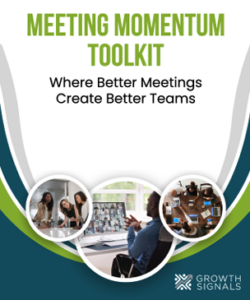In the dynamic landscape of today’s business world, collaboration stands as a cornerstone for achieving and sustaining success. Organizations that prioritize and foster cross-collaboration amongst their teams unlock a myriad of benefits that significantly contribute to better business results.
The collective power of diverse perspectives, skills, and experiences not only fuels creativity and innovation but also enhances problem-solving capabilities. As businesses navigate an ever-changing environment, the ability to adapt, respond swiftly, and streamline operations becomes paramount.
Even the perception of working together can boost performance. A Stanford study found that when participants received cues of working together, they persisted longer on a challenging task, expressed greater interest in and enjoyment of the task, and became more engrossed in and performed better on the task.
What gets in the way of collaboration?
While collaboration is a potent catalyst for organizational success, several barriers often impede its seamless integration within a workplace.
One primary obstacle is the presence of communication breakdowns, where insufficient channels for sharing information or unclear communication protocols hinder the flow of ideas.
Additionally, organizational silos and departmental barriers can create a fragmented work environment, preventing the smooth exchange of knowledge and resources across different teams.
Comfort with the status quo is another formidable hurdle; employees accustomed to traditional workflows may be hesitant to embrace new, collaborative approaches.
Moreover, a lack of a collaborative culture, often stemming from leadership and organizational structure, can hinder efforts to establish teamwork and open communication.
Often, workplace incentives reward individual behavior, undermining the benefits of collaboration. Employees get mixed messages where the organization is touting the importance of collaboration but rewarding individual performance.
Overcoming these barriers is crucial for organizations to unlock the full potential of collaboration and harness the collective intelligence of their workforce.
Addressing these challenges requires a strategic approach, emphasizing transparent communication, dismantling silos, promoting a culture of openness, and providing the necessary tools and training to empower individuals to collaborate effectively.
But what happens when changing the organizational culture is beyond your reach? You focus on what you CAN control – YOU – and how you approach collaboration.
On its surface, collaboration is simply the process of two or more people working together to solve a problem or change something: project work, developing a program, inventing a product, helping a system improve, for example.
But when we look under the hood, collaboration done well is a mindset, a skill set, and a powerful way of accomplishing creative, sturdy win-win solutions — your best work!
Collaboration as a mindset
A mindset, or worldview, is the way we perceive and interpret the world around us. A mindset is formed by a set of values and beliefs which are often unconscious.
At Growth Signals we believe that understanding your beliefs or mindset around any skill or behavior is the first step to actually adopting that skill or behavior.
We’ve been formed and taught to think in terms of hierarchy. Hierarchy has a set of implicit rules based on power and personalities. The underlying value tends to be “I win, you lose.”
Hierarchy has been useful for thousands of years but isn’t always the best way of getting work done that must be co-created with others.
A collaborative mindset, on the other hand, rests on a different kind of power: the power of participation, including many points of view, and finding win-win solutions that work for the greater good of the organization.
It’s based on knowing and including our stakeholders — i.e. individuals or representatives of groups who are affected in some way by whatever it is we’re trying to solve or create. The underlying value is “we win together.”
Collaboration as a skill set
Being an effective collaborator requires us to know our own needs, put them into words, and then hold our views lightly. We have the flexibility to allow that we may be wrong, that we may not have all the information (who could these days?) and that there may be a better idea.
Our own ego is willing to sit down in the back long enough to consider other points of view. We cultivate genuine curiosity about others, truly seeking to understand how they see the world and what a win would look like for them.
As a collaborative facilitator, we develop skills for identifying relevant stakeholders, involving them appropriately, creating productive, effective meetings, and being a neutral guide who ensures everyone has a voice about identifying the problems and the solutions that will affect them.
Collaboration as a way of accomplishing your best work
Collaboration happens when “all the relevant stakeholders have ownership of, and alignment around, what they are going to do and how they are going to do it.”
In a collaborative process, we learn to make it easy for others to:
- feel ownership for the program, project, or change
- contribute their ideas for how to do what needs to be done
- take accountability for and follow through on their commitments
- solve problems, make decisions, resolve conflicts, and communicate effectively
No matter what we’re trying to do: innovate, create, fix, plan — our groups will be able to work together better when we have established a clear, shared understanding about how to solve the right problems, make decisions, resolve conflicts, and communicate effectively.
Seven Tips for Better Collaboration
So, how can you get started in improving your collaboration skills? Here are seven tips to get started.
- Clarify when you need to collaborate. Not every situation requires collaboration. You may not need to collaborate if you have enough – and the right – information to make a decision, when speedy execution is important, or if you’re getting pulled in where you don’t have knowledge or the time to participate.
On the other hand, if you are generating new products or processes, making major decisions that impact others, you need stakeholder input, or you don’t have the information you need to proceed, then collaboration is the way to go.
- Understand your personal limitations with collaboration. Collaboration is not easy to master. If you have internal barriers to collaborating, it will stall you from making progress. Take an honest assessment of what may hold you back from collaborating.
- Recognize how your organization approaches collaboration. If your organization makes it difficult to collaborate, it’s important to know that, as your progress may be slower than you’d like. This may mean you’ll have to be quieter about it and seek to find a few safe people who are willing to collaborate. If you work in a collaborative environment, then it may be part of how you already work.
- Share the big picture. Start each interaction with a problem or opportunity statement. What are you trying to accomplish together?
- Set clear expectations. When you bring people together (and you are leading the group), it’s important to be crystal clear about what you expect from them. That way they can opt in or out of the group, depending on what they can commit to.
- Address conflict early. Not many people enjoy addressing conflict but whenever you’re collaborating, someone will want something different, they’ll fall behind on their duties, or people will disagree. It’s vital to address conflict at the start instead of letting it fester.
- Recognize that collaboration is a continuous process, not a “one-and-done” event. There are many steps to collaborating, buta large part of collaboration includes relationship building. Relationships take work to build and maintain over time. Also, you’ll want to schedule some reflection time to note what you’ve learned and adjust as you move forward in the process.
The significance of collaboration within an organization cannot be overstated, as it serves as a linchpin for achieving better business outcomes.
Despite its undeniable importance, numerous obstacles often impede the seamless integration of collaborative practices. These barriers, ranging from communication breakdowns and organizational silos to resistance to change, underscore the need for a concerted effort to cultivate a collaborative culture.
When embraced wholeheartedly, collaboration becomes the catalyst for accomplishing one’s best work, leveraging the diverse strengths of a team to innovate, problem-solve, and adapt swiftly to challenges.
By embracing collaboration not only as a practice but as part of the culture, organizations can unlock unprecedented levels of creativity, efficiency, and success, positioning themselves for sustained excellence in the ever-evolving business landscape.

